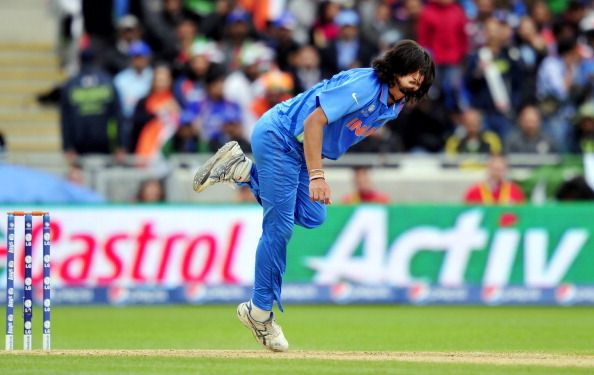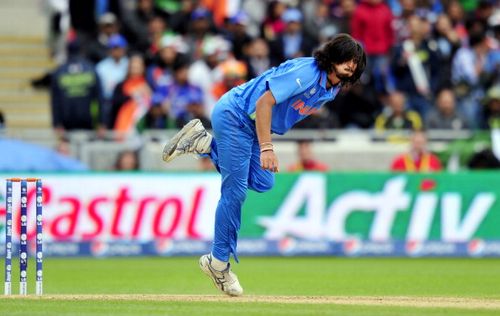
India's death bowling: MS Dhoni's serious concern

Ishant Sharma
The debate about the lack of firepower in Indian bowling, fast bowling to be precise, is an incessant one. Team India’s death bowling woes once again have come to the fore during the ongoing ODI series against Australia, in which the hosts are trailing 1-2, courtesy some wayward bowling.
Indian captain Mahendra Singh Dhoni, after the third ODI in Mohali, admitted that death bowling is a ‘headache’. He said the scenario is getting worse especially with the fifth fielder having to come up inside the 30 yard circle as per the new rules. And the other ICC revision to use two new balls in an ODI innings has seemingly taken the sting out of the Indian bowling attack, which rely heavily on swing and reverse swing. Many cricket pundits have attributed the aforementioned reasons for the recent demise of the quality of bowling, but there certainly are other important factors worth looking into.
Batsmen’s game
The International Cricket Council, in its bid to make the 50 over games more appealing to the public, has from time to time come up with revisions including the introduction of powerplays, which has made the shorter versions tailor-made for batsmen. With most of the limited overs games being played on batting paradises , on grounds with short boundaries, bowlers are taken to the cleaners most times and scores in the vicinity of 300 have become par.
It is not easy being a bowler, but having said that it is a batsmen’s game there is no excuse for spraying the ball all over as the Indian pace bowlers have done thus far in the series. India’s most economical bowler thus far in the series has been Bhuvaneshwar Kumar with an economy of 5.37 but he has only taken a solitary wicket from the three matches that he played. The other strike bowlers Vinay Kumar (7.04) and Ishant Sharma (7.87) have bowled like millionaires and lavishly leaked runs. Ravichandran Ashwin also joined the bandwagon as he gave away 222 runs at an economy of over 6 to take 5 wickets.
Another cause of concern is that the Indians, barring the forth ODI played in Ranchi, were unable to make early inroads with the new ball that allowed the Australian openers to settle and build solid platforms for the middle-order to launch.
Two new balls and many concerns
It was quite a sight to see a Waqar Younis or a Wasim Akram running in with an old ball delivering those toe-crashing reverse swinging yorkers. The reverse swinging yorkers have became a thing of past with ICC deciding to use two new balls in an innings. With reverse swing literally out of the equation, fast bowlers now have to rely on the slower balls to try and restrict the batsmen in the death overs.
But slower balls are always tricky and once the batsman picks it will most probably be dispelled to the boundary . But yorkers are difficult to score off even if it doesn’t reverse as it is difficult for batsmen to get the leverage to play an ariel shot. With the batsmen coming up with adventurous strokes such as the scoops and our skipper’s very own ‘helicopter shot’ the yorkers too are now not being spared. Yes these strokes certainly do exist but they are difficult to execute unlike a slog against length ball. But the Indian pacemen have thus far in the series have bowled minimal number of yorkers which is a cause of bewilderment to fans and pundits alike.
Ishant’s nightmarish over
Have the yorkers gone out of vogue? After having played over 6 years of international cricket Ishant Sharma should have realised that yorkers were the best option when a batsman is looking for the big shots. Instead of bowling it full and straight, Ishant bowled short balls and length balls, which James Faulkner accepted gleefully as he spanked Sharma all over the park scoring 30 runs and altered the course of the game.
Ishant, wilted under pressure, kept bowling into batsman’s corridor and was punished severely. It has to be acknowledged that bowling yorkers under pressure is not an easy task and you have to be an exceptionally gifted bowler like a Lasith Malinga to bowl yorkers at will. But the worrying fact is that he didn’t even attempt neither a yorker nor a slow ball. As Dhoni said in the post-match interview after the 3rd ODI you can’t spoon-feed the bowlers at the international level. Ishant should have gathered his wits and bowled on full or should have varied his pace.
Too many too much
If Ishant’s problem was lack of variations, India’s premier spinner Ravichandran Ashwin is at fault of trying too many things before settling into a rhythm. Ashwin is is trying to bowl too many of his ‘carom balls’ and in the process is spraying the ball all over the wicket. His pause in the action is not only effecting his rhythm but also giving extra time to the batsman to pick his spot. He would be better off bowling his off-spinners at the beginning of his spells and trying out his variations later on.
With the bowlers being put under immense pressure it would be interesting to see what strategy captain Dhoni and his team come up with to win this all important series. Formulating strategy is one thing but do the Indian bowlers have the resolve to execute them? The remaining two matches will be a test of character for the bowlers for sure.